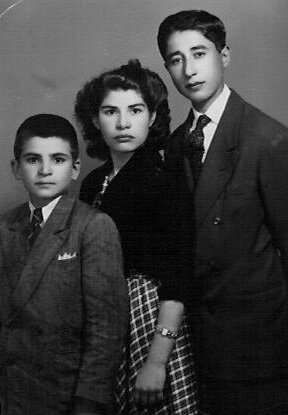Mahin Ahdieh, a Baha’i from Nayriz, took her young nephew for a trip cross Iran in 1956.Their second stop was Tabriz, the capitol of Azerbaijan, a province blessed by the Bab having spent “the saddest, the most dramatic, and in a sense the most pregnant phase of His six year ministry” but, also, “the theatre of His agony and martyrdom.”
Aunt Mahin
The authorities decided to imprison Him in the fortress of Mahku in a remote region of the province in the hope that this would cause His influence to wane. From his dark and cold cell, though, the Bab revealed his Holy Book, the Bayan, meaning “Utterance”.
The Persian Bayan
In an attempt to stem the growth of the Bab’s Faith, the authorities brought Him to Tabriz for a trial, but it was the petty-minded clerics themselves who were judged and condemned by the Bab’s powerful proclamation:
“"I am," he exclaimed, "I am, I am the Promised One! I am the One Whose name you have for a thousand years invoked, at Whose mention you have risen, Whose advent you have longed to witness, and the hour of Whose Revelation you have prayed God to hasten. Verily, I say, it is incumbent upon the peoples of both the East and the West to obey My word, and to pledge allegiance to My person."
Luke Slott, the Promised One
Luke Slott tells about Dr. Cormick, a physician who treated the Bab
On July 9th, 1850, the Bab was brought before a firing squad in a square in Tabriz. After a first thunderous volley of rifles, the smoke cleared, and the Bab had disappeared from sight
Bewilderment spread throughout the spectators. The commander remembered that the Bab had absolved him of responsibility and immediately took his soldiers out of the square. Only when the Bab was ready did the appointed hour come, and after a second volley of rifle fire, He, along with his young devotee, Anis, ascended.
Tabriz, the city from which Shi’a Islam was declared the official religion of Persia became the place where the One who fulfilled its very prophecies was martyred.
“Say God Sufficeth”
The point of the Bab’s Bayan was to prepare the way for Baha’u’llah.
The claims of Baha’u’llah reached Tabriz in the mid-1860s. Tabriz was located on the main road from Iran to Edirne, and Baha’i pilgrims passed through on their way to visiting Baha’u’llah in exile; as a result, most of the Babis as well as others from Tabriz’s diverse population of Azeri Turks, Armenians, and Assyrians became Baha’is.
Tabriz had been the capitol of Iran during several dynastic periods but became a center of the constitutional movement in 1905 and 1911. Tabriz was the first Iranian city affected by modernization and westernization because it was the closest Iranian city to Europe and, consequently, more influenced by the West than the rest of the country. The French consul there was A.L.M. Nicolas who wrote one of the earliest histories of the Bab as well as translated three of the Bab’s major writings into French. Hippolyte and Laura Dreyfus-Barney, the first European Baha’is to visit Iran, came first to Tabriz in 1906.
Hippolyte Dreyfuss


